Education for Sustainability in Practice: A Review of Current Strategies within Italian Universities
Abstract
1. Introduction
- -
- -
- -
- -
- -
- -
- Developing courses directed to real-world collaborative projects for change [25].
2. Literature Review
3. Methods
3.1. Analytical Framework
3.2. Data Collection
| Category | Definition |
|---|---|
| University name | Name of the HEI that is carrying on the initiative, as declared in the RUS survey. |
| N. Students | The number of students at the university (to account the size of the HEI). |
| Type | Type of the HEI in which the initiative is carried on. SSH = institutions devoted primarily to Social Science and Humanities. STEM = institutions devoted primarily to Science, Technology, Engineering and Mathematics. Arts = institutions devoted primarily to arts. |
| Title | Title of the initiative as declared in the RUS survey. |
| EU funding | Presence of EU funding for the initiative as declared in the RUS survey. |
| Goals | Main goals of the initiative as declared in the RUS survey. |
| Category | Meaning |
|---|---|
| Level | Loci of the initiative in the educational management structure in which the educational activity happens. It could be a one-time and not a repeated action; it may be a university course explicitly dedicated to sustainable matters, or a program (an entire sequence of classes), or a whole university unit (a department, a green team, UNESCO chair, etc.), or a virtual place where the educational activities are conducted by a network of researchers or practitioners. |
| Approach | The pedagogical method applied in the observed case study. i.e., frontal lecture, experiential learning, problem-project based learning, etc. A further definition of all the approach categories is given in Table 5. |
| Urban Outreach | The stakeholders involved in the educational experience, i.e., NGOs, city councils, social welfare associations, etc. |
| Sustainable Development Goals (SDGs) | The SDGs embedded and addressed through that educational practice, even when not elicited. For instance, a leadership training education course aims at a quality of education for all (SDG4). It targets stakeholders of industries and decision-makers to take action in the responsible production and consumption patterns, with developed countries taking the lead (SDG12). |
| Driver | The direction of the process for initiating and developing the educational activity: it could be top-down when decided from the leadership or the university authorities, or bottom-up, when born among student associations or spontaneous university staff uniting towards a sustainability goal. |
| Mission | The type of task (research, teaching, and third mission). For instance, students’ engagement activities in energy conservation projects fall into the research and teaching mission, while the inclusion of citizens in a waste-collection programme around the neighbourhood recap the third mission. We define the third mission as the effort to link the university’s activity with its socio-economic context, according to [43]. |
| On the map | This column refers to 12 types of action to implement HEI that have been performed by Italian University that participated in the RUS call. These types have been identified by the authors and are described in detail in Section 5. |
| University | N. Students (2018) | Type | Title | EU Funding Integration | Goals |
|---|---|---|---|---|---|
| Università di Bologna | 84,720 | SSH + STEM | UniBo Green Office | Yes | Student engagement; networking among universities; networking among urban stakeholders; job market skills. |
| Politecnico di Milano | 45,000 | STEM | Polimi4SDGs | No | Mapping of SDGs related activities; data collection about education al activities referred to Agenda 2030 goals. |
| Politecnico di Milano | 45,000 | STEM | 4 MSc programs | No | Theoretical framework of environmental engineering, environmental sustainability; energy for development and sustainable architecture. |
| Politecnico di Milano | 45,000 | STEM | Postgraduate courses | No | Theoretical Framework; specialization on specific topics (Energy, Buildings, infrastructures, temporary reuse, renewal energies). |
| Politecnico di Milano | 45,000 | STEM | Honorous path: engineering for sustainable development | No | Specialization in engineering for sustainable development. |
| Politecnico di Milano | 45,000 | STEM | Unesco chair: energy for sustainable development | Yes [UN] | Specialization in energy for sustainable development. |
| Politecnico di Milano | 45,000 | STEM | Postgraduate: Coopera(c)tion: knowledge and skills for sustainable cities in the global South | Yes | Social Impact; soft skills; sustainability awareness. |
| Politecnico di Milano | 45,000 | STEM | 2 EU Pr: LeNSin + SUSTAIN T | Yes | Networking among universities; improve internationalization; intercultural cross fertilization, accessibility of higher education. |
| Politecnico di Milano | 45,000 | STEM | 2 MOOCS on sustainability | No | Specialization in sustainable building design; social entrepreneurship. |
| Politecnico di Torino | 31,500 | STEM | 2 MSc programs: systemic design and sustainable architecture | No | Specialization in sustainable architecture; systemic design. |
| Politecnico di Torino | 31,500 | STEM | Green Team | No | Resources optimization; integrated environmental education for university students; Participation in university governance; developing strategies for disseminating among university students environmental responsiveness and sustainability culture. |
| Politecnico di Torino | 31,500 | STEM | Honorous path: Young Talent Program | No | System thinking; complexity awareness; social impact; local solutions; soft skills. |
| Politecnico di Torino | 31,500 | STEM | SDGs mapping | No | Mapping of SDGs related activities; data collection about educational activities referred to Agenda 2030 goals. |
| Università Ca’ Foscari | 21,529 | SSH | Active Learning Lab—Urban Innovation | No | Network among urban stakeholders; knowledge transfer; innovation hub; job market skills; social impact. |
| Università dell’insubria | 10,000 | SSH | Waste Management Feasibility Project | No | Waste management; environmental awareness. |
| Università di Bari | 48,000 | SSH | Environmental sustainability | No | Social impact; soft skills; system thinking. |
| Università di Napoli “L’Orientale” | 11,685 | SSH | Project within “Ethics and Market” course | No | Community needs assessment; local set of solutions; sustainability awareness. |
| Università di Napoli “l’Orientale” | 11,685 | SSH | Migrations and sustainable development project | No | Social impact; soft skills; sustainability awareness; improve internationalization; intercultural cross fertilization, accessibility to higher education. |
| Università di Napoli “l’Orientale” | 11,685 | SSH | Open Doors Summer School on Migration Sea Borders Control and Human Rights (CeMiRiMed) | Yes | Networking among universities; policies; knowledge transfer; system thinking. |
| Università di Parma | 22,500 | SSH + STEM | Italian Center for Environmetal Research and Education | / | Transdisciplinary research and education. |
| Università di Parma | 22,500 | SSH + STEM | Department of Chemical Life Sciences and Environmental Sustainability | / | Transdisciplinary research and education. |
| Università di Parma | 22,500 | SSH + STEM | BSc Food System: Sustainability Management and Technology | / | Social impact; system thinking. |
| Università di Parma | 22,500 | SSH + STEM | Sustainability in University Teaching Programmes | No | Sustainability education; SSH integration; network among urban stakeholders. |
| Università di Perugia | 23,877 | SSH + STEM | MSc in Circular design | No | System thinking; sustainability education; complexity awareness; job market skills orientation. |
| Università di Siena | 16,400 | SSH + STEM | Sustainability open course (6 CFU) | No | Sustainability theoretical framework; external stakeholders engagement. |
| Università di Siena | 16,400 | SSH + STEM | Summer school for Sustainable Development | / | Sustainability theoretical framework; external stakeholders engagement. |
| Università di Torino | 70,500 | SSH | Unito Go | / | Students’ engagement; network among universities; network among urban stakeholders; job market skills. |
| Università di Torino | 70,500 | SSH | Leadership Training for Education for Sustainable Development | No | Sustainability theoretical framework; soft skills; local set of solution. |
| Università di Torino | 70,500 | SSH | Postgraduate program in Socio-environmental sustainability of Agro-food network | No | Job market skills; sustainability theoretical framework; complexity awareness. |
| Università di Torino | 70,500 | SSH | Unito for International Cooperation | Yes (?) | Social impact; network; sustainability awareness; complexity awareness. |
| Università IUAV | 4600 | ARTS | No Title—Trigeneration powerplant and organization of visits for students | No | Sustainable energy production; sustainability awareness. |
| University | Title | Level | Approach | Urban Outreach | SDGs | Driver | Mission | On the map | Legend |
|---|---|---|---|---|---|---|---|---|---|
| Università di Bologna | UniBo Green Office | University unit | Experiential | City Council | 11; 17; 4; 13; 12; 6; 8 | Bottom-Up | 3rd mission | Renew a part or an entire existing building | 12 |
| Politecnico di Milano | Polimi4SDGs | University unit | / | / | / | Top-Down | 3rd mission | Draw a map, give a compass | 1; 2 |
| Politecnico di Milano | 4 MSc programs | Program | Problem/project-based; lectures | / | 7; 9 | Top-Down | Teaching | Building something new | 11 |
| Politecnico di Milano | Postgraduate courses | Program | Problem/project-based; lectures | / | 7; 11; 9 | Top-Down | Teaching | Building something new or do building maintenance | 11; 5 |
| Politecnico di Milano | Honorous Path: engineering for sustainable development | Course | Problem/project-based; lectures | / | 7; 9 | Top-Down | Teaching | Building something new or do building maintenance | 11; 5 |
| Politecnico di Milano | Unesco chair: Energy for sustainable development | University unit | Problem/project-based; lectures | / | 11; 7; 13; 16; 4 | Top-Down | Teaching; Research | Elevate temples | 9 |
| Politecnico di Milano | Postgraduate: Coopera(c)tion: knowledge and skills for sustainable cities in the global South | Program | Problem/project-based; lectures | / | 10; 4 | Top-Down | Teaching; 3rd Mission | Put up tents outside | 4 |
| Politecnico di Milano | 2 EU Pr: LeNSin + SUSTAIN T | Network | Experiential; challenge-based; | NGOs; Local Health Offices; Social Welfare Associations | 4; 5; 16; 8; 10 | Top-Down | Teaching | Trace trails | 7 |
| Politecnico di Milano | 2 MOOCS on sustainability | Course | Online lectures | / | 4; 11; 7; 5 | Top-Down | Teaching | Put aerial outside the houses | 8 |
| Politecnico di Torino | 2 MSc program: Systemic design + Sustainable architecture | Program | Problem/project-based; lectures | / | 7; 9; 11 | Top-Down | Teaching | Building something new do building maintenance | 11; 5 |
| Politecnico di Torino | Green Team | University unit | Holistic | Local experts, Municipal Council; NGOs; Social Welfare Associations | 11; 17; 4; 13; 12; 6; 8 | Top-Down | Operational aspects; 3rd mission | Make it rain | 3 |
| Politecnico di Torino | Honorous Path: Young Talent Program | Course | Challenge-based; problem/project-based; experiential; transdisciplinarity | Local Experts; Social Welfare associations, business | 11; 7; 4; 7; 9; 10; 12; 13 | Top-Down | Teaching | Building something new | 11 |
| Politecnico di Torino | SDGs mapping | University unit | / | / | / | Top-Down | 3rd mission | Draw a map, give a compass | 1; 2 |
| Università Ca’ Foscari | Active Learning Lab—Urban Innovation | Course | Lectures | Business; City Council; NGOs | 8; 4; 1; 11; 12; 17 | Top-Down | Teaching; 3rd Mission | Do building and soil maintenance | 5 |
| Università dell’insubria | Waste Management Feasibility Project | University unit | Experiential | / | 12 | Top-Down | Operational aspects | Trace trails | 7 |
| Università di Bari | Environmental sustainability | Course | Challenge-based; problem/project-based; experiential | / | 4; 12; 17; 13 | Top-Down | Teaching | Do building and soil maintenance | 5 |
| Università di Napoli “L’Orientale” | Project within “Ethics and Market” course | Spot initiative | Problem/project-based; experiential | / | 3; 4; 10; 11; 12 | Top-Down | Teaching; Operational aspects | Make it rain | 3 |
| Università di Napoli “l’Orientale” | Migrations and sustainable development | Spot initiative | Challenge-based; experiential | NGOs; Local Health Offices; Social Welfare Associations | 10; 4 | Top-Down | Teaching; 3rd Mission | Put up tents outside | 4 |
| Università di Napoli “l’Orientale” | Open Doors Summer School on Migration Sea Borders Control and Human Rights (CeMiRiMed) | Spot initiative | Challenge-based | NGOs (local and international); | 4; 5; 16; 8; 10 | Top-Down | Teaching; 3rd Mission | Building playfields for sustainability education | 10 |
| Università di Parma | Italian Center for Environmental Research and Education | University unit | Lectures | Schools | 4; 17 | Top-Down | Teaching; Research | Power factories and labs with SDGs fuel | 6 |
| Università di Parma | Department of Chemical Life Sciences and Environmental Sustainability | University unit | Lectures | Business | 4; 17; 12 | Top-Down | Teaching; Research | Power factories and labs with SDGs fuel | 6 |
| Università di Parma | BSc Food System: Sustainability Management and Technology | Program | Lectures; experiential | Business | 4; 17; 12; 1 | Top-Down | Teaching | Houses along the path | 5; 11 |
| Università di Parma | Sustainability in University Teaching Programmes | Spot initiative | Interdisciplinarity; staff, professor and student engagement | Local experts | 17; 16 | Top-Down | Teaching | Rain collector tank | 3 |
| Università di Perugia | MSc in Circular design | Program | Interdisciplinarity; problem/project-based courses; local stakeholder engagement | Business | 8; 9; 12 | Top-Down | Teaching; Technological Transfer | Building something new do building maintenance | 5; 11 |
| Università di Siena | Sustainability open course | Course | Lectures | Local experts | 4 | Top-Down | Teaching | Put aerial outside the houses | 8 |
| Università di Siena | Summer school for Sustainable Development | Spot initiative | Interdisciplinarity; problem/project-based courses; local stakeholder engagement | Local experts, Municipal Council; NGOs; Social Welfare Associations; business | 4; 17 | Top-Down | Teaching | Building playfields for sustainability education | 10 |
| Università di Torino | Unito Go | University unit | Experiential | City Council | 11; 17; 4; 13; 12; 6; 8 | Bottom-Up | 3rd mission | Renew a part or an entire existing building | 12 |
| Università di Torino | Leadership Training for Education for Sustainable Development | Spot initiative | Problem/project-based courses; multidisciplinarity | / | 12; 4 | Top-Down | Teaching; Operational aspects | Do building and soil maintenance | 5 |
| Università di Torino | Postraduate program in Socio-environmental sustainability of Agro-food network | Program | Problem/project-based courses; multidisciplinarity | Local experts, Municipal Council; NGOs; Social Welfare Associations | 4; 2; 12; 15; 17 | Top-Down | Teaching | Do building and soil maintenance | 5 |
| Università di Torino | UniTo for International Cooperation | University unit | Experiential; problem/project-based courses; multidisciplinarity | NGOs; Local experts; Municipal Council; Businesses; | 1; 4; 5; 6; 10; 11; 12; 13; 14; 15; 16; 17 | Top-Down | Teaching; 3rd Mission | Trace trails and bridges | 7 |
| Università IUAV | No Title—Trigeneration powerplant and organization of visits for students | University unit | Dissemination | Business | 7 | Top-Down | Operational aspects | Trace trails and bridges | 7 |
4. Results
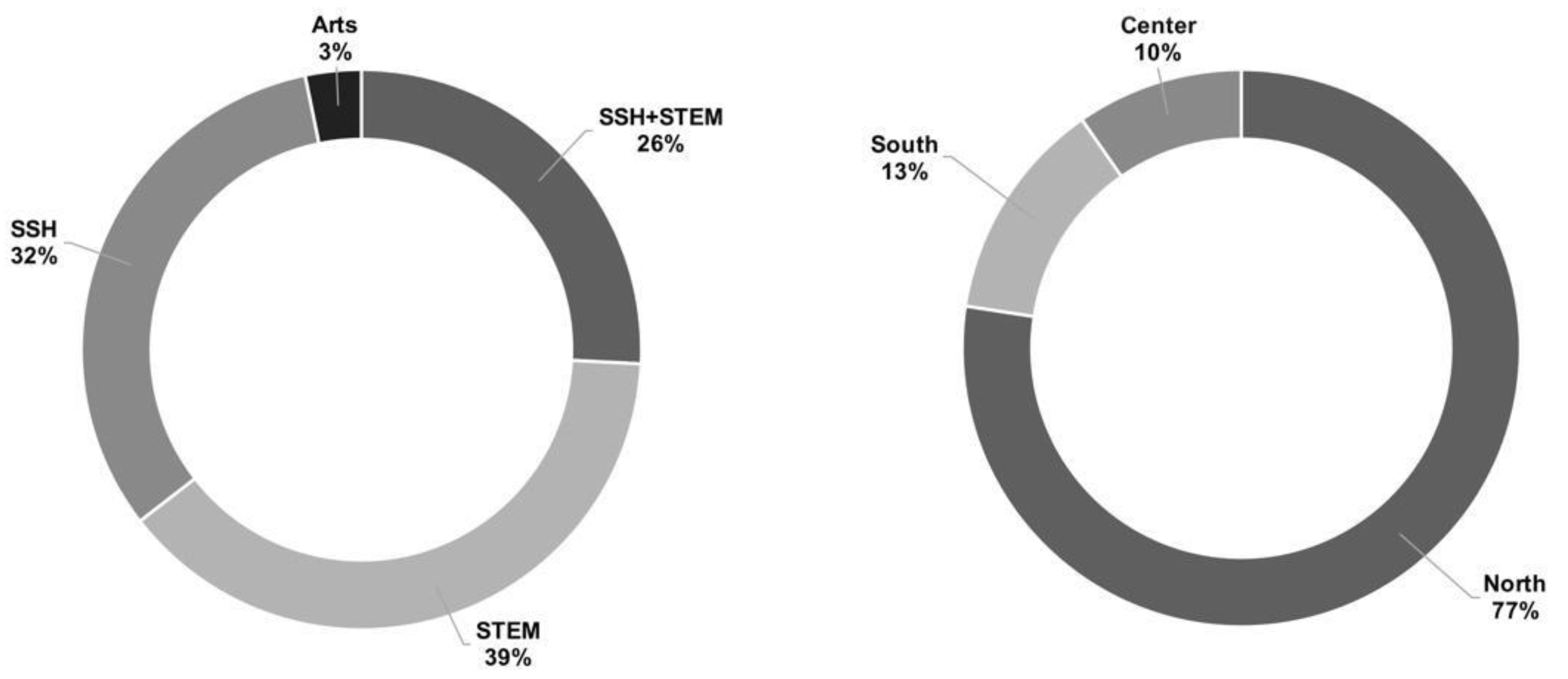
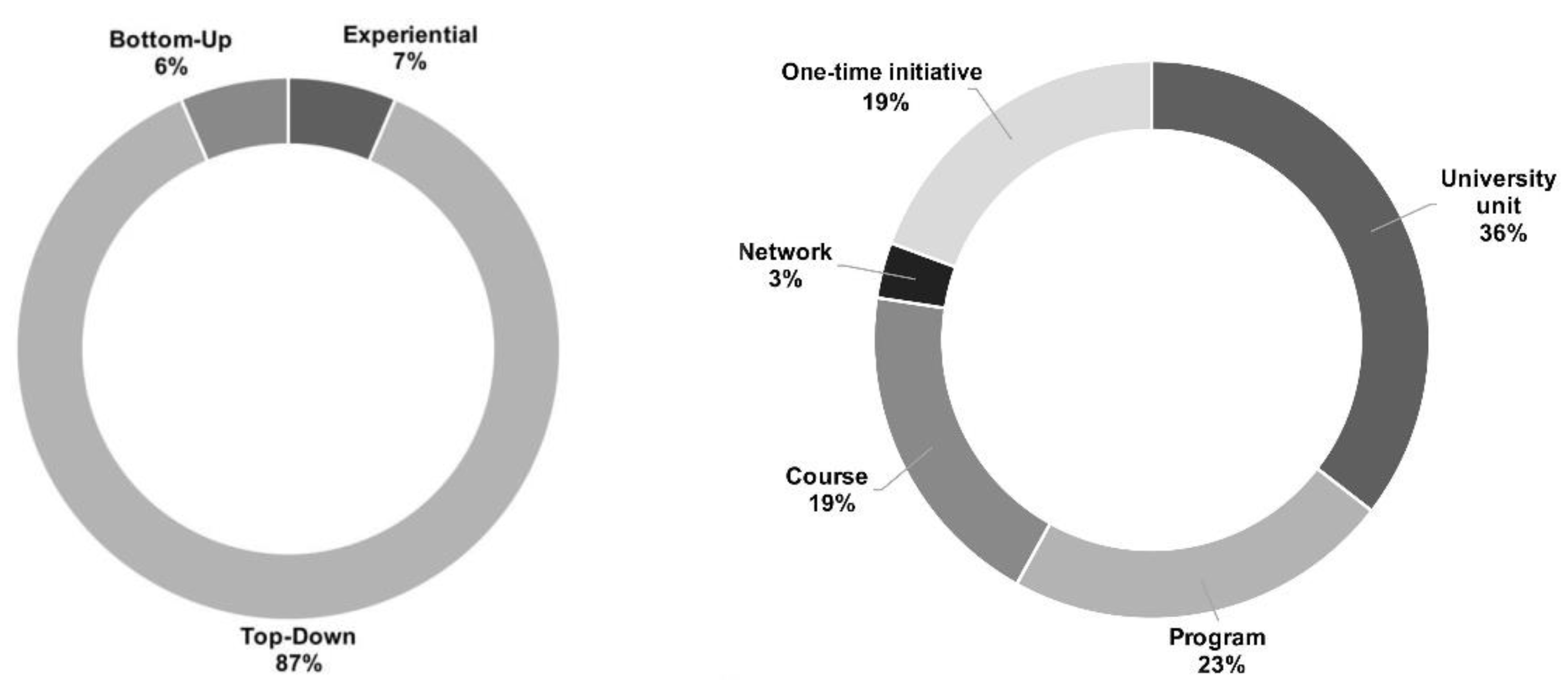
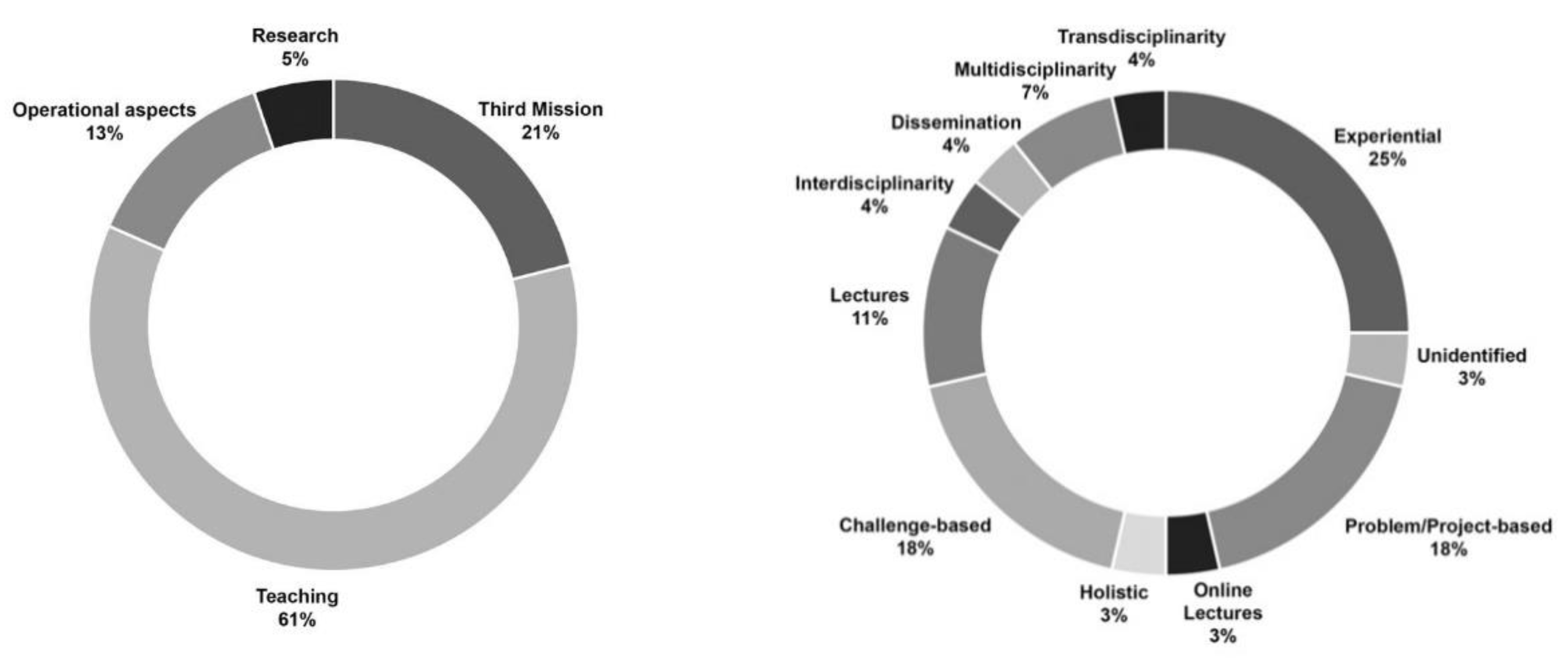
| Methods and Tools | Definitions and Sources |
|---|---|
| Transdisciplinarity | Transdisciplinary projects are those in which efforts conducted by persons from different disciplines and backgrounds working jointly to create new conceptual, theoretical, methodological, and translational innovations that integrate and move beyond discipline-specific approaches to address a common problem. Trans-disciplinary work moves beyond the bridging of divides within academia to engage directly with the production and use of knowledge outside of the academy [25,44]. |
| Multidisciplinarity | Multidisciplinarity involves studying a topic using several different discipline perspectives at the same time. Any topic will ultimately be enriched by the sum of the disciplinary perspectives when the multidisciplinary approach overflows disciplinary boundaries. Participants, however, work within the respective frameworks of their disciplines [45,46,47]. |
| Interdisciplinarity | Interdisciplinarity happens in any study or group of studies undertaken by scholars from two or more distinct scientific disciplines. It is based upon a conceptual model that links or integrates theoretical frameworks from those disciplines, uses study design and methodology that is not limited to any one field, and requires the use of perspectives and skills of the involved disciplines throughout multiple phases of the research process [48]. |
| Dissemination | All the university’s activities meant to spread information, knowledge, and opinions widely about the SDGs. |
| Lectures/Online lectures | Any educational talk to an audience, especially one offered to the students in a university. |
| Challenge-based | A “challenge-based” approach is a combined set of relevant challenges approached with a collaborative inquiry. It begins with a content-relevant challenge and is followed by a request for learners to generate their initial thoughts about the challenge, access to student-controlled audio and video resources (essentially mini-lectures) designed to deepen learners’ initial thoughts, a chance for small-group discussions about the challenge and resources, and finally a large-group discussion that includes key ideas students have learned and further questions for the instructor [49]. |
| Holistic | The aim and focus of holistic learning are making connections, e.g., connections between subjects or between thinking and intuition [50]. The transdisciplinary approach of holistic type, that overcomes the disciplinary fragmentation, reports a vision of the world and life, as comprehensive as possible, and looks at the human nature with all its complexity and diverse forms of manifestation [51]. |
| Problem/project-based | Problem-Based Learning is a teaching method in which complex real-world problems are used as the vehicle to promote student learning of concepts and principles as opposed to direct presentation of facts and concepts. In addition to course content, it can promote the development of critical thinking skills, problem-solving abilities, and communication skills. It can also provide opportunities for working in groups, finding and evaluating research materials, and life-long learning [52]. While with challenge-based learning students are asked to develop solutions to a complex problem incorporating technology into the process and to propose real-world solutions, the goal of problem/project-based learning is to complete a critical thinking exercise and come up with a project that may solve a specific problem. |
| Experiential training | Experiential training helps students develop knowledge, skills, and values from direct experiences outside of a traditional academic setting. It encompasses internships, service learning, undergraduate research, study abroad, and other creative and professional work experiences [53]. |
| Unidentified | We did not assign categories to those initiatives which were poorly described. |
5. Discussion
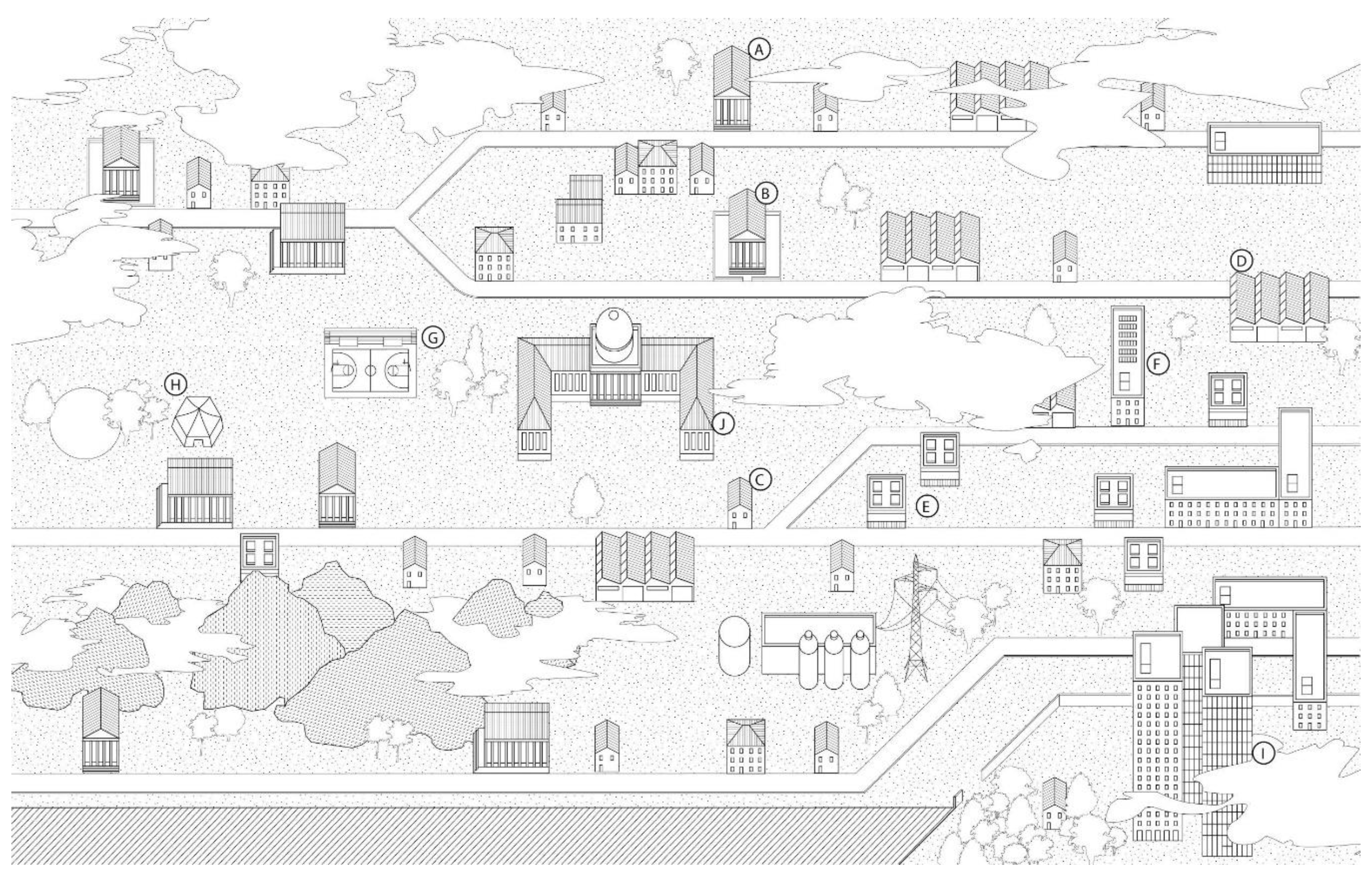
- the temples: the theoretical foundations of disciplines, available to all students (e.g., Physics, Mathematics, History of Architecture, etc.);
- the temples with fences: the theoretical foundations of disciplines, but specifically dedicated to a certain degree (Fluid Dynamics, Compositional principles, Anatomy, etc.);
- the houses: a theoretical course inside one or more degree courses (technical physics, structural engineering, interior design, etc.);
- the factory: a laboratory for experiential learning (wind tunnel, chemistry experiments, architectural model crafting, etc.);
- the atelier: a course in which a project is a central part (architectural design, electric circuit design, model design, etc.);
- the building block: the research experience inside a degree course (thesis project, essays, special seminars);
- the playfield: a limited learning experience around a specific topic (summer school, student challenges, hackathons, etc.);
- the tent: temporary learning experiences (bottom-up initiatives by students, teamwork around a societal challenge, etc.);
- the suburbs: outside learning experience from different stakeholders (an internship in companies, in public administrations, in NGOs, etc.);
- the main building: the administration and general direction of the university.
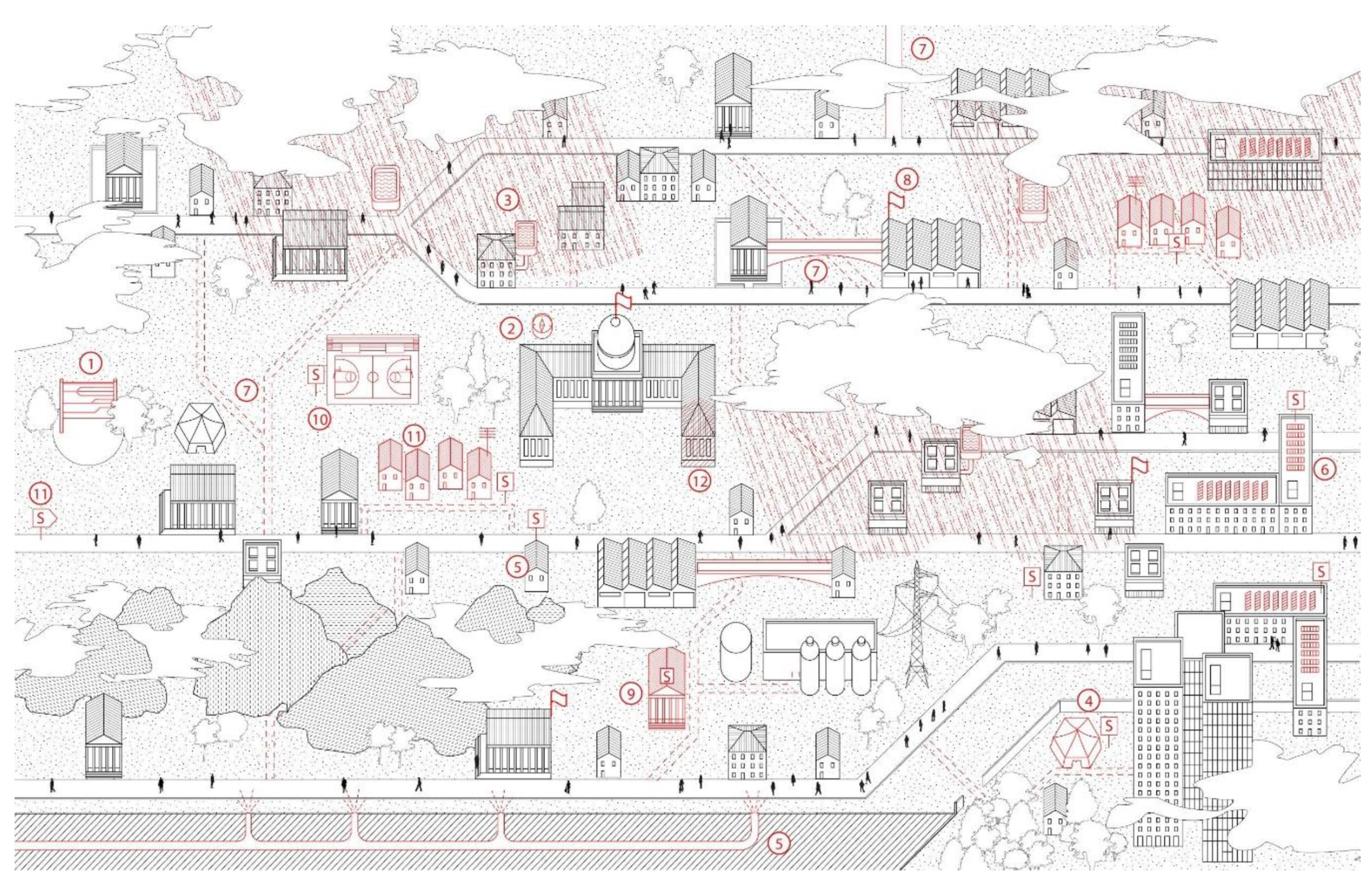
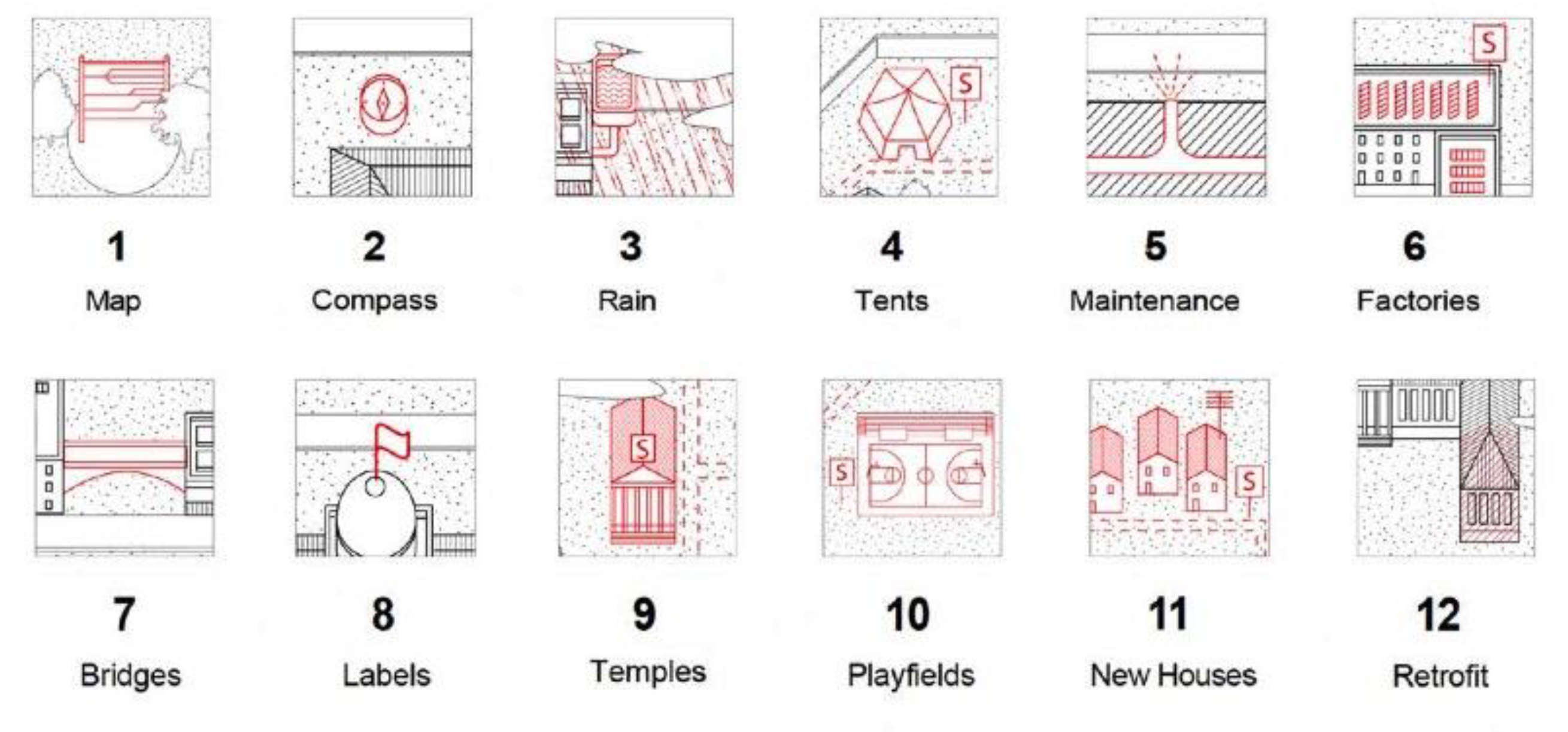
6. Conclusions
Author Contributions
Funding
Conflicts of Interest
Abbreviations
| AIESEC | Association Internationale des Etudiants en Sciences Economiques et Commerciales |
| ASvis | Alliance for Sustainable Development |
| CRUI | Conferenza dei Rettori delle Università Italiane—Italian Rectors’ board |
| EfS | Education for Sustainability |
| ECTS | European Credit Transfer and Accumulation System |
| HEIs | Higher Education Institutions |
| POLITO | Politecnico di Torino |
| RUS | Rete Italiana Università per la Sostenibilità—Italian Network of Sustainable Universities |
| SD | Sustainable Development |
| SDGs | Sustainable Development Goals |
| SSH | Social Science and Humanities |
| STEM | Science, Technology, Engineering and Mathematics |
References
- Colglazier, W. Sustainable development agenda: 2030. Science 2015, 349, 1048–1050. [Google Scholar] [CrossRef] [PubMed]
- Huckle, J.; Sterling, S.R.; Sterling, S. Education for Sustainability; Earthscan: London, UK, 1996. [Google Scholar]
- Tilbury, D. Environmental education for sustainability: Defining the new focus of environmental education in the 1990s. Environ. Educ. Res. 1995, 1, 195–212. [Google Scholar] [CrossRef]
- Shephard, K. Higher education for sustainability: Seeking affective learning outcomes. Int. J. Sustain. High. Educ. 2008. [Google Scholar] [CrossRef]
- Cortese, A.D. The critical role of higher education in creating a sustainable future. Plan. High. Educ. 2003, 31, 15–22. [Google Scholar]
- Sonetti, G. Energy and architecture—An overview. In Proceedings of the EPJ Web of Conferences, Varenna, Italy, 22–27 July 2013; Volume 54. [Google Scholar]
- Sonetti, G.; Lombardi, P.; Chelleri, L. True green and sustainable university campuses? Toward a clusters approach. Sustainability 2016, 8, 83. [Google Scholar] [CrossRef]
- Sonetti, G.; Brown, M.; Naboni, E. About the triggering of UN sustainable development goals and regenerative sustainability in higher education. Sustainability 2019, 11, 254. [Google Scholar] [CrossRef]
- Boks, C.; Diehl, J.C. Integration of sustainability in regular courses: Experiences in industrial design engineering. J. Clean. Prod. 2006, 14, 932–939. [Google Scholar] [CrossRef]
- Wemmenhove, R.; de Groot, W.T. Principles for university curriculum greening—An empirical case study from Tanzania. Int. J. Sustain. High. Educ. 2001, 2, 267–283. [Google Scholar] [CrossRef]
- Disterheft, A.; Caeiro, S.; Azeiteiro, U.M.; Filho, W.L. Sustainable universities—A study of critical success factors for participatory approaches. J. Clean. Prod. 2014, 106, 11–21. [Google Scholar] [CrossRef]
- Disterheft, A.; da Silva Caeiro, S.S.F.; Ramos, M.R.; de Miranda Azeiteiro, U.M. Environmental Management Systems (EMS) implementation processes and practices in European higher education institutions—Top-down versus participatory approaches. J. Clean. Prod. 2012, 31, 80–90. [Google Scholar] [CrossRef]
- Lozano, R. Diffusion of sustainable development in universities’ curricula: An empirical example from Cardiff University. J. Clean. Prod. 2010, 18, 637–644. [Google Scholar] [CrossRef]
- Komiyama, H.; Kraines, S. Vision 2050: Roadmap for a Sustainable Earth; Springer: Berlin, Germany, 2008. [Google Scholar]
- SDSN Australia/Pacific. Getting Started with the SDGs in Universities: A Guide for Universities, Higher Education Institutions, and the Academic Sector. Australia, New Zealand and Pacific Edition; Sustainable Development Solutions Network—Australia/Pacific: Melbourne, Australia, 2017. [Google Scholar]
- Leal Filho, W.; Shiel, C.; Paço, A.; Mifsud, M.; Ávila, L.V.; Brandli, L.L.; Molthan-Hill, P.; Pace, P.; Azeiteiro, U.M.; Vargas, V.R.; et al. Sustainable Development Goals and sustainability teaching at universities: Falling behind or getting ahead of the pack? J. Clean. Prod. 2019, 232, 285–294. [Google Scholar] [CrossRef]
- Pallant, E.; Choate, B.; Haywood, B. How do you teach undergraduate university students to contribute to UN SDGs 2030? In Universities as Living Labs for Sustainable Development; Springer: Berlin, Germany, 2020; pp. 69–85. [Google Scholar]
- Albareda-Tiana, S.; Ruíz-Morales, J.; Azcárate, P.; Valderrama-Hernández, R.; Múñoz, J.M. The EDINSOST project: Implementing the sustainable development goals at university level. In Universities as Living Labs for Sustainable Development; Springer: Berlin, Germany, 2020; pp. 193–210. [Google Scholar]
- Ferreira, J.-A.; Evans, N.; Davis, J.M.; Stevenson, R.; Evans, N. Teacher Education and Education for Sustainability. Learn. Embed. Sustain. Teach. Educ. 2019, 1, 7–21. [Google Scholar]
- Kolb, M.; Fröhlich, L.; Schmidpeter, R. Implementing sustainability as the new normal: Responsible management education—From a private business school’s perspective. Int. J. Manag. Educ. 2017, 15, 280–292. [Google Scholar] [CrossRef]
- Disterheft, A.; Caeiro, S.S.; Leal Filho, W.; Azeiteiro, U.M. The INDICARE-model–measuring and caring about participation in higher education’s sustainability assessment. Ecol. Indic. 2016, 63, 172–186. [Google Scholar] [CrossRef]
- Jorge, M.L.; Madueño, J.H.; Cejas, M.Y.C.; Peña, F.J.A. An approach to the implementation of sustainability practices in Spanish universities. J. Clean. Prod. 2015, 106, 34–44. [Google Scholar] [CrossRef]
- Mulder, K.F.; Ferrer, D.; Segalas Coral, J.; Kordas, O.; Nikiforovich, E.; Pereverza, K. Motivating students and lecturers for education in sustainable development. Int. J. Sustain. High. Educ. 2015, 16, 385–401. [Google Scholar] [CrossRef]
- Mawonde, A.; Togo, M. Implementation of SDGs at the University of South Africa. Int. J. Sustain. High. Educ. 2019. [Google Scholar] [CrossRef]
- Bammer, G.; O’Rourke, M.; O’Connell, D.; Neuhauser, L.; Midgley, G.; Klein, J.T.; Grigg, N.J.; Gadlin, H.; Elsum, I.R.; Bursztyn, M.; et al. Expertise in research integration and implementation for tackling complex problems: When is it needed, where can it be found and how can it be strengthened? Palgrave Commun. 2020, 6, 1–16. [Google Scholar] [CrossRef]
- RUS Rete delle Università per lo Sviluppo Sostenibile. Available online: https://sites.google.com/unive.it/rus/home (accessed on 1 May 2020).
- AIESEC Association Internationale des Etudiants en Sciences Economiques et Commerciales. Available online: https://aiesec.org/ (accessed on 1 May 2020).
- ASvIS Italian Alliance for Sustainable Development. Available online: http://asvis.it/ (accessed on 1 May 2020).
- Evans, T.L. Occupy Education: Living and Learning Sustainability. In Global Studies in Education; Peter Lang Inc.: New York, NY, USA, 2012; Volume 22. [Google Scholar]
- Carter, J.H. A Review of “Occupy Education: Living and Learning Sustainability” Tina Lynn Evans. New York; Peter Lang: Bern, Switzerland, 2012; p. 331. [Google Scholar]
- Spangenberg, J.H. Hot air or comprehensive progress? A critical assessment of the SDGs. Sustain. Dev. 2017, 25, 311–321. [Google Scholar] [CrossRef]
- Aikens, K.; McKenzie, M.; Vaughter, P. Environmental and sustainability education policy research: A systematic review of methodological and thematic trends. Environ. Educ. Res. 2016, 22, 333–359. [Google Scholar] [CrossRef]
- Lozano, R.; Ceulemans, K.; Alonso-Almeida, M.; Huisingh, D.; Lozano, F.J.; Waas, T.; Lambrechts, W.; Lukman, R.; Hugé, J. A review of commitment and implementation of sustainable development in higher education: Results from a worldwide survey. J. Clean. Prod. 2014, 108, 1–18. [Google Scholar] [CrossRef]
- Mulder, K.F.; Segalas, J.; Ferrer-Balas, D. How to educate engineers for/in sustainable development: Ten years of discussion, remaining challenges. Int. J. Sustain. High. Educ. 2012, 13, 211–218. [Google Scholar] [CrossRef]
- Gasca-Pliego, E.; Olvera-García, J.C. Construir ciudadanía desde las universidades, responsabilidad social universitaria y desafíos ante el siglo XXI. Convergencia 2011, 18, 37–58. [Google Scholar]
- Eisler, R.; Quinn, R.E.; Scharmer, O.; Wilson, S. Social change for a healthy world: Leading meaningfully. In Academy of Management Proceedings; Academy of Management Briarcliff Manor: Briarcliff Manor, NY, USA, 2016; Volume 2016, p. 10619. [Google Scholar]
- Camfield, L.; Crivello, G.; Woodhead, M. Wellbeing research in developing countries: Reviewing the role of qualitative methods. Soc. Indic. Res. 2009, 90, 5. [Google Scholar] [CrossRef]
- Woiwode, C. Off the beaten tracks: The neglected significance of interiority for sustainable urban development. Futures 2016, 84, 82–97. [Google Scholar] [CrossRef]
- Tejedor, G.; Segalàs, J.; Barrón, Á.; Fernández-Morilla, M.; Fuertes, M.T.; Ruiz-Morales, J.; Gutiérrez, I.; García-González, E.; Aramburuzabala, P.; Hernández, À. Didactic Strategies to Promote Competencies in Sustainability. Sustainability 2019, 11, 2086. [Google Scholar] [CrossRef]
- Segalàs, J.; Tejedor, G. Service Learning for Engineering Education for Sustainability. In Proceedings of the ICEE21C 217: 1st International Conference on Engineering Education for the XXI Century, Castelló, Spain, 6–7 July 2017. [Google Scholar]
- RUS la Didattica per lo Sviluppo Sostenibile Negli Atenei Italiani. Available online: https://www.unive.it/pag/27453/ (accessed on 1 May 2020).
- RUS la Didattica per lo Sviluppo Sostenibile Negli Atenei Italiani Best Practice. Available online: https://www.unive.it/pag/fileadmin/user_upload/comunicazione/sostenibile/doc/RUS/BrochureA5_web.pdf (accessed on 1 May 2020).
- Frondizi, R.; Fantauzzi, C.; Colasanti, N.; Fiorani, G. The Evaluation of Universities’ Third Mission and Intellectual Capital: Theoretical Analysis and Application to Italy. Sustainability 2019, 11, 3455. [Google Scholar] [CrossRef]
- Klein, J.T. Reprint of “Discourses of transdisciplinarity: Looking back to the future”. Futures 2015, 65, 10–16. [Google Scholar] [CrossRef]
- Nicolescu, B. Multidisciplinarity, Interdisciplinarity, Indisciplinarity, and Transdisciplinarity: Similarities and Differences. RCC Perspect. 2014, Volume, 19–26. [Google Scholar]
- Lauder, A.; Sari, R.F.; Suwartha, N.; Tjahjono, G. Critical review of a global campus sustainability ranking: GreenMetric. J. Clean. Prod. 2015, 108, 852–863. [Google Scholar] [CrossRef]
- Choi, B.C.K.; Pak, A.W.P. Multidisciplinarity, interdisciplinarity and transdisciplinarity in health research, services, education and policy: 1. Definitions, objectives, and evidence of effectiveness. Clin. Investig. Med. 2006, 29, 351. [Google Scholar]
- Aboelela, S.W.; Larson, E.; Bakken, S.; Carrasquillo, O.; Formicola, A.; Glied, S.A.; Haas, J.; Gebbie, K.M. Defining interdisciplinary research: Conclusions from a critical review of the literature. Health Serv. Res. 2007, 42, 329–346. [Google Scholar] [CrossRef]
- O’Mahony, T.K.; Vye, N.J.; Bransford, J.D.; Sanders, E.A.; Stevens, R.; Stephens, R.D.; Richey, M.C.; Lin, K.Y.; Soleiman, M.K. A comparison of lecture-based and challenge-based learning in a workplace setting: Course designs, patterns of interactivity, and learning outcomes. J. Learn. Sci. 2012, 21, 182–206. [Google Scholar] [CrossRef]
- Miller, J.P. Holistic Learning: A Teacher’s Guide to Integrated Studies; ERIC: Toronto, Canada, 1990. [Google Scholar]
- Jeder, D. Transdisciplinarity—The advantage of a holistic approach to life. Procedia-Soc. Behav. Sci. 2014, 137, 127–131. [Google Scholar] [CrossRef]
- Duch, B.J.; Groh, S.E.; Allen, D.E. The Power of Problem-Based Learning: A Practical “How-To” for Teaching Undergraduate Courses in Any Discipline; Stylus Publishing, LLC.: Sterling, VA, USA, 2001. [Google Scholar]
- Williams, S.D.; Graham, T.S.; Baker, B. Evaluating outdoor experiential training for leadership and team building. J. Manag. Dev. 2003, 22, 45–59. [Google Scholar] [CrossRef]
- ILO ITC ILO Training Centre. Available online: https://www.itcilo.org/en (accessed on 1 May 2020).
- UNESCO UNESCO CHAIRS. Available online: http://www.unesco.org/new/en/natural-sciences/about-us/how-we-work/unesco-chairs/ (accessed on 1 May 2020).
- Lozano, R.; Carpenter, A.; Huisingh, D. A review of ‘theories of the firm’ and their contributions to Corporate Sustainability. J. Clean. Prod. 2014, 106, 430–442. [Google Scholar] [CrossRef]
- Kalsoom, Q.; Khanam, A. Inquiry into sustainability issues by preservice teachers: A pedagogy to enhance sustainability consciousness. J. Clean. Prod. 2017, 164, 1301–1311. [Google Scholar] [CrossRef]
- Schweinsberg, S.; Wearing, S.L.; McManus, P. Exploring sustainable tourism education in business schools: The honours program. J. Hosp. Tour. Manag. 2013, 20, 53–60. [Google Scholar] [CrossRef]
- Cullingford, C.; Blewitt, J. The Sustainability Curriculum: The Challenge for Higher Education; Routledge: Abingdon, UK, 2013. [Google Scholar]
- Baptista, B.V.; Vasen, F.; Soto, J.C.V. Interdisciplinary centers in Latin American Universities: The challenges of institutionalization. High. Educ. Policy 2019, 32, 461–483. [Google Scholar] [CrossRef]
- Annan-Diab, F.; Molinari, C. Interdisciplinarity: Practical approach to advancing education for sustainability and for the Sustainable Development Goals. Int. J. Manag. Educ. 2017, 15, 73–83. [Google Scholar] [CrossRef]
- Summers, J.J.; Svinicki, M.D. Investigating classroom community in higher education. Learn. Individ. Differ. 2007, 17, 55–67. [Google Scholar] [CrossRef]
- Sonetti, G.; Arrobbio, O.; Lombardi, P.; Lami, I.M.; Monaci, S. “Only Social Scientists Laughed”: Reflections on Social Sciences and Humanities Integration in European Energy Projects. Energy Res. Soc. Sci. 2020, 61, 101342. [Google Scholar] [CrossRef]
- Hart, D.D.; Bell, K.P.; Lindenfeld, L.A.; Jain, S.; Johnson, T.R.; Ranco, D.; McGill, B. Strengthening the role of universities in addressing sustainability challenges: The Mitchell Center for Sustainability Solutions as an institutional experiment. Ecol. Soc. 2015, 20, 4. [Google Scholar] [CrossRef]
- Tejedor, G.; Segalàs, J.; Rosas-Casals, M. Transdisciplinarity in higher education for sustainability: How discourses are approached in engineering education. J. Clean. Prod. 2018, 175, 29–37. [Google Scholar] [CrossRef]
- Scharmer, O. The Essentials of Theory U: Core Principles and Applications; Berrett-Koehler Publishers: San Francisco, CA, USA, 2018. [Google Scholar]
- Jandrić, P.; Boras, D. Critical Learning in Digital Networks; Springer: Berlin, Germany, 2015. [Google Scholar]
- Bartosik-Purgat, M.; Filimon, N.; Kiygi-Calli, M. Social media and higher education: An international perspective. Econ. Sociol. 2017, 10, 181–191. [Google Scholar] [CrossRef]
- Salvioni, D.M.; Franzoni, S.; Cassano, R. Sustainability in the higher education system: An opportunity to improve quality and image. Sustainability 2017, 9, 914. [Google Scholar] [CrossRef]
© 2020 by the authors. Licensee MDPI, Basel, Switzerland. This article is an open access article distributed under the terms and conditions of the Creative Commons Attribution (CC BY) license (http://creativecommons.org/licenses/by/4.0/).
Share and Cite
Sonetti, G.; Barioglio, C.; Campobenedetto, D. Education for Sustainability in Practice: A Review of Current Strategies within Italian Universities. Sustainability 2020, 12, 5246. https://doi.org/10.3390/su12135246
Sonetti G, Barioglio C, Campobenedetto D. Education for Sustainability in Practice: A Review of Current Strategies within Italian Universities. Sustainability. 2020; 12(13):5246. https://doi.org/10.3390/su12135246
Chicago/Turabian StyleSonetti, Giulia, Caterina Barioglio, and Daniele Campobenedetto. 2020. "Education for Sustainability in Practice: A Review of Current Strategies within Italian Universities" Sustainability 12, no. 13: 5246. https://doi.org/10.3390/su12135246
APA StyleSonetti, G., Barioglio, C., & Campobenedetto, D. (2020). Education for Sustainability in Practice: A Review of Current Strategies within Italian Universities. Sustainability, 12(13), 5246. https://doi.org/10.3390/su12135246






